Repairing broken pottery with the Japanese craft of Kintsugi
Shipping pottery from Morocco to London, there have been a few breakages. Despite the fragile labels, shipping companies are hardly delicate with parcels. The biggest of the breakages was the parcel of beautiful striped cups that were almost all broken on arrival. The breakages were upsetting, but couldn’t bear to throw all of them away.
I searched for a solution and thought about Kintsugi, but the thought of sitting down and putting those pieces together did not appeal. I looked for other solutions but, as there was a nationwide lockdown, I suddenly had a lot of time and decided to complete this jigsaw puzzle. After hours of research, I decided on the kit I needed and went ahead with the work. Here are the steps I worked through.

- Gold Mica Powder
- Epoxy Resin: I bought SigWong (the pack comes with gloves and wooden craft sticks)
- A scalpel
- A few plastic/wooden craft sticks
- A smaller tool to apply the resin
- A tool to mix the resin and powder together
- A small plastic mixing tray
The first step is to find all the broken pieces of the object and ensure they all fit well. Tape them together until you are ready to fix them. If you have a smooth surface along the break, you should file the edge down to create a rough surface.


Get your tools together and keep them within easy reach of your working area. This can be quite a messy process and you will want to keep everything as organsed as you can.
Make sure you are working on a surface which you do not mind getting dirty. I added a tea towel underneath my working area to avoid getting resin on the table.
When you are ready add the two part resin to your mixing tray. Most exposy resin will come in a two part dispenser (these may not be food safe) or a two part resin which needs mixing. The resin I bought needs to be mixed which was relatively simple. The pack will more than likely come with gloves, measuring cups and craft sticks. add your preferred measure of the resin and the hardener in each cup. The measure of needs to be exactly the same. Then add this to your mixing tray. Add a small amount of mica powder to the mixing tray and mix until absorbed.



When your mixture is smoothly mixed you may need to wait a little while until it hardens. If you have a fast-acting resin you can work immediately. The gold resin should be the texture of toothpaste when it is this texture it is ready to apply.
When you are ready to apply, take the tape of your object and slowly apply a good amount of gold resin to the surface of the break. You only need to apply the resin to one-half of the two pieces you are glueing. If you have a few pieces build broken pieces together to finish up with large pieces which can then be glued together.
When you have put your pieces together hold them for a while and make sure that the pieces will hold themselves together without your aid, if they can you can leave them to dry. You will need to dry the piece for over 8 hours. The resin will bulge out of the cracks and create a gold seam.
If the gold resin has bulged out of the cracks a little too much you can use your scalpel to remove this and add more gold resin along the crack to create a smoother seam. When the resin is wet you can add more powder over this with your dry brush. Dip the brush into the powder and use your finger to flick the powder of the resin. When your object is completely dry you can wipe it clean and it will be ready to use.



Today I broke my pottery piece and heartbroken. Thanks for the guide.
Oh no, what a shame, I hope this helps and let me know if you need any tips, Jane